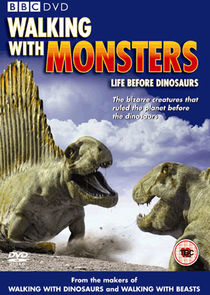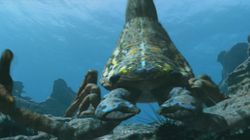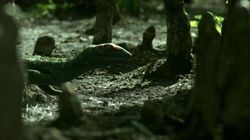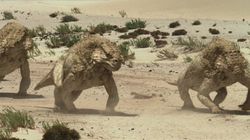Walking with MonstersSéta a szörnyekkel

Befejezett / kaszált 2005.12 - 2005.11 | 60 perc @BBC One , GB
Alkotó: Tim Haines
Galéria
Kenneth Branagh (Narrator),
Avery Brooks (Narrator)
Honlap | IMDb | SorozatJunkie | TV Maze | TMDB
12.08.
22:00

Epizód adatlap | SorozatJunkie | IMDb | Hozzászólások (0) |
530 million years ago: Cambrian Place: Chengjiang, China Oxygen Content: 30% below today Hazards: world's first super predator
The first episode begins with an illustration of the giant impact hypothesis: approximately 4.4 billion years ago when the Earth was formed, it is conjectured that a planet-like object referred to as Theia collided into the early Earth, dynamically reshaping the Earth and forming the moon. The episode then jumps ahead to the Cambrian Explosion, showing the first diversification of life in the sea. Strange arthropod predators called Anomalocaris feed on trilobites, and fight with each other, whereupon the wounded loser is attacked by a school of Haikouichthys, described as the first vertebrate.
Animals: Anomalocaris · Haikouichthys · Redlichiida (unidentified trilobite) · Jellyfish
418 million years ago: Silurian Place: South Wales, UKOxygen Content: 30% below today Hazards: giant scorpions
The segment moves on to the Silurian period, where Haikouichthys has evolved into the jawless-fish Cephalaspis. The marine scorpion Brontoscorpio pursues a Cephalaspis but falls victim to the giant eurypterid Pterygotus, whose young feed on the smaller scorpion's body. Later a shoal of Cephalspis migrate into the shallows to spawn, navigating via memory thanks to their advanced (for the time) vertebrate brains. As they cross a shallow embankment, they are ambushed by several Brontoscorpio which are depicted as the first animals capable of walking on land. Several fish are killed but the majority slip past the feasting scorpions and arrive at the spawning site. One scorpion misses this feeding opportunity due to having to molt its skin.
Animals: Cephalaspis · Brontoscorpio · Pterygotus · Cameroceras (identified as Orthocone) · Sea sponge · Sea urchin
360 million years ago: Devonian Place: Pennsylvania, USA Oxygen Content: 20% below today Hazards: giant killer fish
A short sequence depicts Cephalaspis evolving into Hynerpeton (bypassing the lobe-finned fish stage), amphibian-like tetrapods, who now hunt their arthropod contemporaries which have shrunk. Though capable of terrestrial movement, Hynerpeton have to remain near water to keep moist and reproduce. A lone male Hynerpeton hunting underwater is threatened by predatory fish, at first by a Stethacanthus which is eaten by a two-ton Hyneria that chases the amphibian out of the water. After seeing off a rival during the night, the male finds a receptive female at dawn and the two mate at the water's edge. They are ambushed by the Hyneria, which beaches herself in the process, but then uses her fins to drag herself ashore and grab the fleeing male. Despite his untimely death, the Hynerpeton eggs were successfully fertilized and sink into the water to develop. A sequence depicts them acquiring hard shells as the first reptiles evolve, but as the offspring leave their nest, those still hatching are left at the mercy of a giant spider, foreshadowing the return of the arthropods.
Animals: Hynerpeton · Hyneria · Stethacanthus (identified as primitive shark) · Scorpion · Petrolacosaurus
12.15.
22:00

Epizód adatlap | SorozatJunkie | IMDb | Hozzászólások (0) |
300 million years ago: Carboniferous Place: Kansas, USA Oxygen Content: 40% above today Hazards: giant insects
The second episode shows the swampy coal forests of the Carboniferous. It explains that because of a much higher oxygen content in the atmosphere, giant land arthropods evolved, such as a Mesothelae spider (a member of the primitive spider suborder), Meganeura; a giant dragonfly the size of a eagle and Arthropleura; a huge millipede relative. A Mesothelae hunts down a Petrolacosaurus. She comes back from her hunting expedition only to find her burrow has flooded. Not only that, the Petrolacosaurus she caught is stolen by a Meganeura. On the spider's search for a new burrow, she passes a pond full of Reptiliomorphs (which would make a more central appearance later on). Later she is chased by an Arthropleura, which is later killed in a fight with a Proterogyrinus. The Mesothelae finally chases a Petrolacosaurus out of its own burrow and moves in. A storm brews and the narrator explains that its high oxygen content makes the atmosphere very combustible, so lightning is a real danger. The Proterogyrinus are seen leaping out of the water to catch Meganeura, which were driven below the tree canopy by the storm. Later, lightning and a forest fire pour in, devastating the life around. At last, only some animals survive... including Petrolacosaurus, who finds the dead body of the Mesothelae (her burrow was at the centre of a lightning strike) and begins to feed upon the spider's carcass.
Animals: · Primitive Mesothelae · Petrolacosaurus · Meganeura · Arthropleura · Proterogyrinus (identified as an Amphibian)
280 million years ago: Early Permian Place: Bromacker, GermanyGlobal Temp: 20% colder than today Hazards: extreme seasons
The episode then moves on to the Early Permian, where the swamp-loving trees of the Carboniferous have been replaced with more advanced conifers that are better adapted to survive in a changing climate. Petrolacosaurus and a few other diapsids have evolved into the sub-group of creatures called pelycosaurs like the Edaphosaurus which are now closely related to mammals. They live in herds and have outgrown their arthropod contemporaries in size. A pregnant female Dimetrodon, another pelycosaur, hunts the Edaphosaurus herd, beginning with a fake charge to expose the weak and the juveniles. She finally kills a baby Edaphosaurus, but is forced to abandon her kill when the scent of blood attracts others of her kind, all highly-aggressive males. She builds a nest on a hill and is watched by an egg-stealing Reptiliomorph. Some time after laying her eggs, another gravid Dimetrodon tries to take over her nest. After a long duel, the original female drives off the intruder, but is badly injured and fatigued in the process. A male Dimetrodon approaches the now unguarded nest, but luckily kills the thieving reptiliomorph and leaves the eggs unharmed. The eggs hatch and the mother's bond with her offspring is severed. The episode ends with the wounded mother joining other adult Dimetrodon in attacking her own young which race to the trees and hide in dung to escape. At the end the narrator says that the reptiles will evolve to tighten their grip on land, becoming "new reptiles."
Animals: Dimetrodon · Edaphosaurus · Seymouria (identified as an egg-eating amphibian) · Meganeura
12.22.
22:00

Epizód adatlap | SorozatJunkie | IMDb | Hozzászólások (0) |
250 million years ago: Late Permian Place: Siberia Global Temp: 60% hotter than today Hazards: extreme heat, volcanic activity
The third episode is set in the Late Permian, on the supercontinent Pangaea, which was covered by a vast and inhospitable desert. In this arid climate, early therapsids, which are described as more "mammal-like" than reptile, are shown fighting to survive alongside other animals. The programme starts with an old Scutosaurus, a relative of turtles, being killed by a female Inostrancevia, a type of gorgonopsid which later joins others of her kind at a small waterhole. Other inhabitants of the area include Diictodon, a small burrowing dicynodont. In the pool itself is a starving labyrinthodont that ambushes the female gorgonopsid in desperation and quickly retreats. A herd of Scutosaurus arrive and eventually drink the waterhole dry. The female gorgonopsid tries to dig out a pair of Diictodon but is unsuccessful. Upon returning to the waterhole, she unearths the labyrinthodont wrapped in a "cocoon" which it utilized to survive drought. In a torpid state, it is helpless and quickly killed. The gorgonopsid is eventually killed by a sandstorm, foreshadowing the oncoming Permian–Triassic extinction event. The Diictodon meanwhile are able to adapt by digging their burrows deeper, occasionally unearthing plant tubers for sustenance.
Animals: Inostrancevia (identified as Gorgonopsid) · Diictodon · Rhinesuchus (identified as Labyrinthodont) · Scutosaurus
248 million years ago: Early Triassic Place: Antarctica Global Temp: 40% hotter than today Hazards: Ambush Predators
Diictodon is seen evolving into the larger Lystrosaurus. The Lystrosaurus multiply into vast herds that must continually migrate in order to find fresh foliage. Also featured is the small insectivorous Euparkeria that is depicted as an ancestor of the dinosaurs. When the Lystrosaurus herd traverses a ravine, one is killed by a pack of venomous Therocephalians, though the herd doesn't show concern for the victim. Encountering a river, the herd enters the water and is attacked by numerous Proterosuchus. Many are killed, but the majority escape and continue their migration. The narrator explains that despite the dominance of Lystrosaurus, eventually the world will recover in full from the Permian-Triassic extinction event and other reptiles will overtake them. The episode ends as a Euparkeria is confronted by a Proterosuchus: as the smaller reptile rapidly begins to evolve into an Allosaurus and the scene cuts to the Late Jurassic where it passes two Stegosaurus, the narrator explains that mammals are destined to be confined to the shadows as a new group of animals becomes the dominant species on Earth. The Age of Monsters is over. This is the beginning of the Age of Dinosaurs.
Animals: Lystrosaurus · Euparkeria · Proterosuchus (identified as Chasmatosaur) · Euchambersia (identified as Therocephalian) · prehistoric Dragonfly Late Triassic (220 MYA)/Late Jurassic (150 Mya) · Allosaurus · Stegosaurus · Diplodocus (archive footage) · Anurognathus (archive footage) · Brachiosaurus (archive footage) · Epanterias



